
Caterpillars are the larval stage of the species Lepidoptera, aka Butterflies and Moths. However, larvae of sawflies are also called caterpillars, as well as some other insects whose larvae have a caterpillar like shape (what are called eruciform bodies).
Caterpillars are typically voracious feeders and often are considered to be pests. There are possibly over 20,000 species of butterflies and over 150,000 species of moths in the world.
Some 750 species of butterflies and 11,000 species of moths found in the US. Bottom line – there are a lot of caterpillars. Most of them do not sport the colors of an adult moth or butterfly.
Caterpillars will often change colors as they grow up.
Caterpillars Change Color!
Caterpillar colors may be hard to pin down at times, due to a number of reasons.
Firstly, caterpillars may change color over time as they move from an early stage to late.
Second, it is entirely possible for caterpillars to change color based on where they live (e.g. which tree, twig or leaf they dwell on) and what they eat.
In general, caterpillars are not often correlated with the color of the adult insect that they metamorphose into.
Some of the descriptions below depend on the most striking color that a species of caterpillar might sport at some stage of their lifecycle, as opposed to what they always look like.
So where do the colors come from?
There are two types of colors found on caterpillars:
- (a) natural pigmentation
- (b) structural colors.
Natural pigmentation stays the same whenever or wherever you see it. But with structural colors, the angle at which light hits the caterpillar’s body will cause the color to change – a shimmering effect we call iridescence.
Caterpillars can be colorful, but in most cases, their main objective is to make it past the larval stage into an adult moth or butterfly. Therefore, they tend to adopt colors such as green, brown, orange, yellow or black – these provide great camouflage and help caterpillars blend into their natural habitat, aka leaves and plants which they feed on.
However, some caterpillars have bright colors such as black, red and yellow – in such cases, the colors typically signal to would be predators that the caterpillars would be toxic if consumed.
Essentially, bright colors along with raised spines or bristles represent natural defenses for these creatures. Some of the more iridescent colors such as purple, blue and pink are not common in caterpillars.
The caterpillars described below include both iridescent and natural pigmentation driven colors.
Can Caterpillars Be Green?
Green is one of the most natural colors found on a wide range of caterpillars. Given their habitat, aka leaves and plants, green helps caterpillars camouflage themselves well.
Some of the better-known species of green caterpillars are outlined below.
Are Green Caterpillars Rare?
Green caterpillars are extremely common. They tend to be smooth bodied. Some of the largest and fattest insects are green caterpillars. One of the largest species is the Emperor Moth Caterpillar (Saturnia pavonia).
Another large species, the Luna Moth Caterpillar (Actias luna) has a spiky pale green body. The Tomato Hornworm Caterpillar (Manduca quinquemaculata) is a common garden pest that feeds on tomato plants.
They are sometimes confused with the similarly shaped Tobacco Hornworm (Manduca sexta), also a voracious pest. Another hornworm is the White-lined Sphinx caterpillar (Hyles lineata).
The Winter Moth Caterpillar (Operophetra brumata) is an inch-long caterpillar that has grown to be an invasive species feeding on trees such as oak, beech, maple and willow, as well as raspberry and blueberry shrubs.
The Tiger Swallowtail Caterpillar (Papilio glaucus) emits a foul stench when attacked. The European Puss Moth Caterpillar (Cerura vinula) is a variation of the normal, brown Puss Moth Caterpillars and extremely venomous.
Where Can They Be Found?
Green caterpillars are common all over the world. Emperor Moth Caterpillars are found in open countryside all over the British Isles, as well as across Northern Europe and China. Luna Moth Caterpillars can be found in Central and Eastern US, Canada and occasionally in Western Europe.
The Tomato Hornworm and the Tobacco Hornworm are mostly found in the Northern states of the US and southern Canada. The White-lined Sphinx Caterpillars are widely distributed in North America, the Caribbean, parts of Eurasia and Africa.
Winter Moth Caterpillars are found in Northern and Central Europe and as far south as Northern Italy. In the US, they are found on the Eastern Seaboard and parts of the Pacific Northwest.
The Tiger Swallowtail is extremely common all over the eastern US, and one species has been spotted in Ireland. European Puss Moth Caterpillars are found all over Europe, across temperate Asia to China and in North Africa.
Green Caterpillar Examples & ID Guide
Typically, green caterpillars have distinctive markings, but they blend in with green foliage which makes it hard to identify them.
Emperor Moth Caterpillar
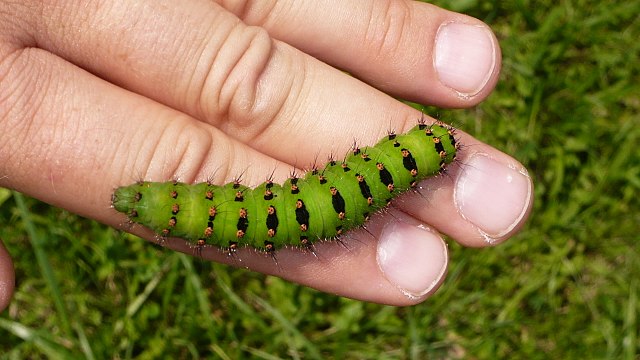
The larvae of the Emperor Moth Caterpillar are black and orange.
As adults, they turn bright to dark green with bands of black-ringed orange and yellow spots.
Luna Moth Caterpillar
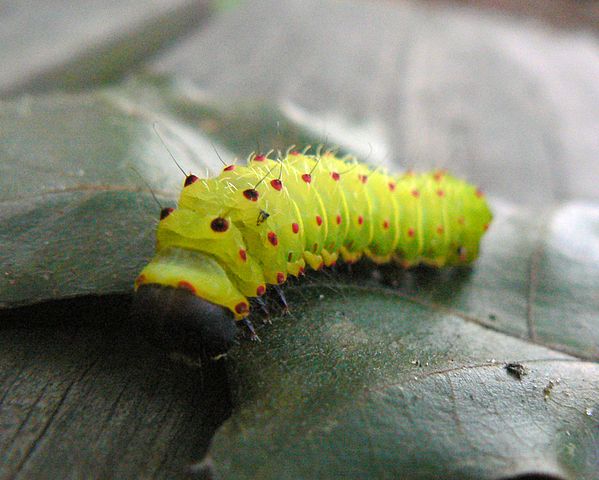
The Luna Moth Caterpillar has a ridged and spiky body with red or orange spots – it also turns reddish-brown before cocooning. They are large grubs, up to 3.5″ in size.
Tomato Hornworm & Tobacco Hornworm Caterpillars
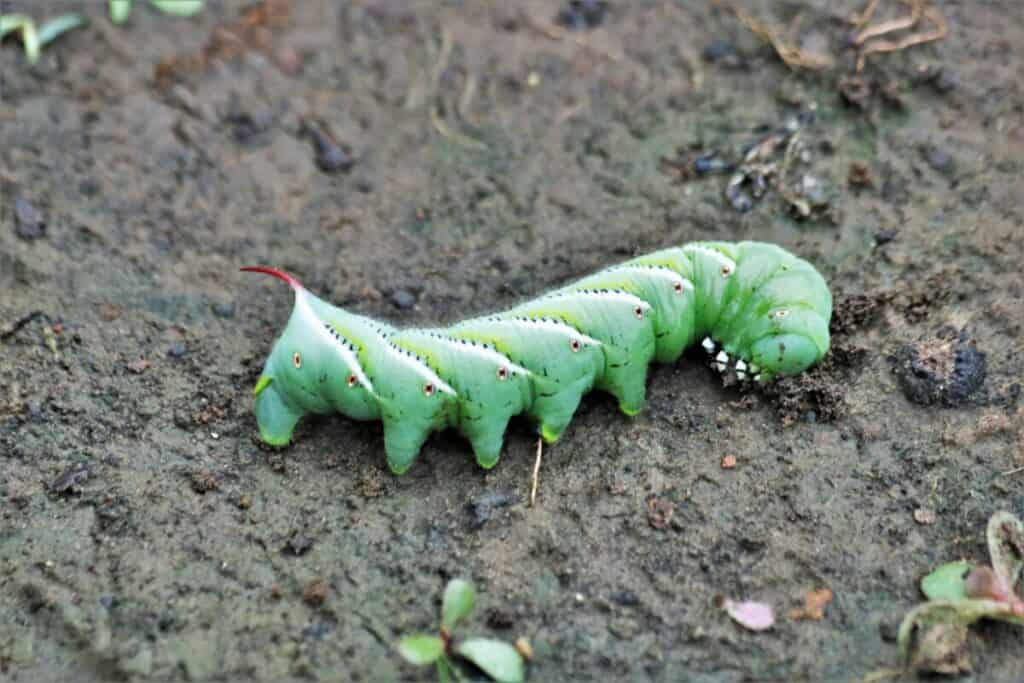
The Tomato Hornworm Caterpillars have V-shaped white markings on their body and a larger head than the rest of the body, plus a protruding tail that looks like a spike or horn.
The Tobacco Hornworm looks similar but is found among tobacco plants.
White-Lined Sphinx Caterpillar
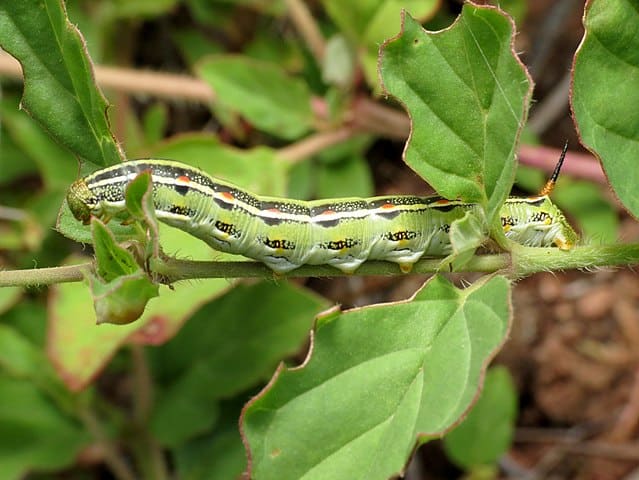
The White-Lined Sphinx Caterpillar can be black, but is usually lime-green in color, with orange or yellow spots and a distinctive orange and black horn on its tail.
The Winter Moth Caterpillar
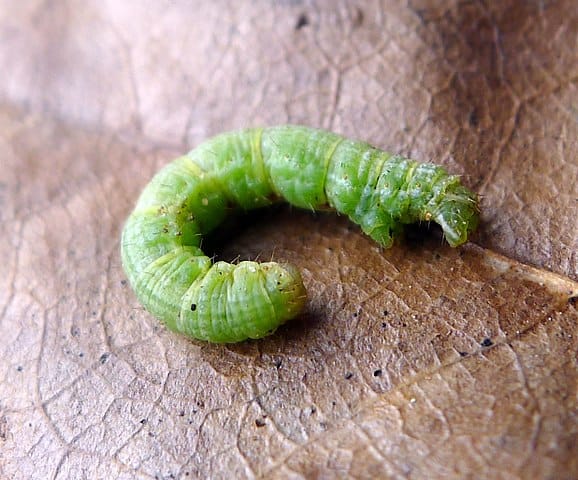
The Winter Moth Caterpillar is small in size (one inch), so you’ll easily tell it apart from other, larger caterpillars. The Inchworm has only two legs at its rear end while others in the family have multiple legs.
Tiger Swallowtail Caterpillar
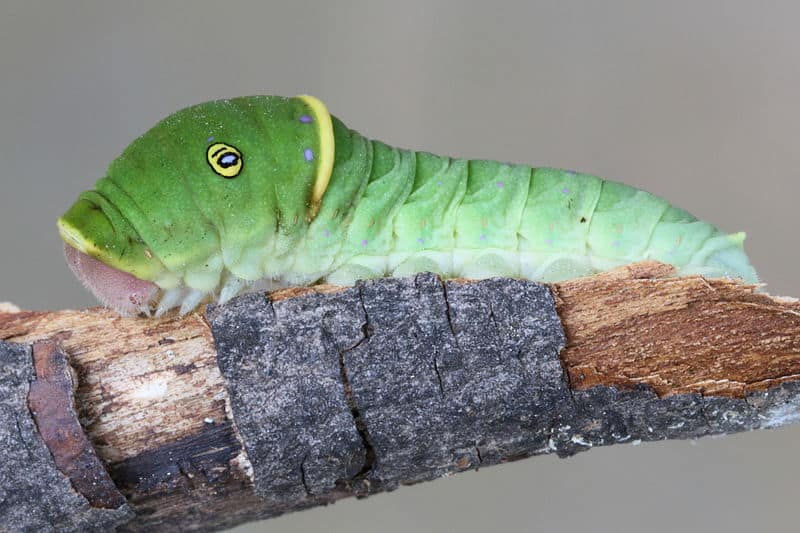
They have pale stripes running down the length of their bodies. The green Tiger Swallowtail Caterpillar has unusually distinctive eyelike markings on its head. It is dark green throughout most of its life, then turns dark brown just before pupation.
European Puss Moth Caterpillar
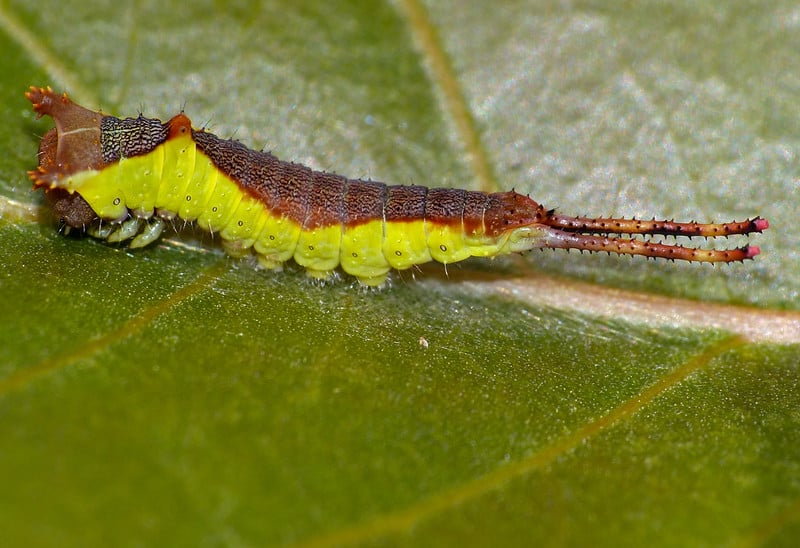
The European Puss Moth Caterpillar is unusually distinctive, which is a good thing since its dangerous – it can even spit poisonous acid when threatened. Its fat, smooth and lime-green in color and has two large spiked tails at one hand and what looks like a teeth-gnashing black head with pink borders at the other!
Can Caterpillars Be Yellow?
Yellow colors in caterpillars often occur in conjunction with natural pigmentation such as black, or green or blue iridescence.
Are Yellow Caterpillars Rare?
Yellow being a primary pigmentation, it’s common to find shades of gold and yellow in caterpillars.
Common species found in North America include the Yellow Woolly Bear Caterpillar (Spilosoma virginica), the Yellow-spotted Tussock Moth Caterpillars (Lophocampa maculata), the Sycamore Tussock Moth Caterpillar (Halysidota harrisii) and the American Dagger Moth Caterpillar (Aronicta americana).
The Pale Tussock Caterpillar (Calliteara pudibunda) is another species of tussock caterpillars. A huge and unusual species is the Giant Peacock Moth Caterpillar (Saturnia pryi), also known as the Giant Emperor Moth or Viennese Emperor.
The Six-spot Burnet (Zygaena filipendulae) is another yellow caterpillar that looks like a fat slug, their coloration helping keep predators away. One of the commercially valuable caterpillars is the Tasar Silkworm Caterpillar (Antheraea mylitta) found in the wild in India.
Their silk is considered to be of higher quality than the domesticated Silkworm, which is described in the Grey Colored Caterpillar section.
Where Can They Be Found?
Generally, yellow and black species are common all over the world, with the exception of Antarctica.
The Yellow Woolly Bear can be found all over North America, especially in lowland areas.
Yellow-spotted Tussock Moth Caterpillars are common in southern Canada, the Great Lakes and Eastern US – Sycamore Tussock Moth Caterpillars occupy the same range and also extend into Northeastern Mexico. American Dagger Moth Caterpillars are common all over the US, especially at higher elevations.
Pale Tussock Caterpillars are common in England, Wales and Ireland. Giant Peacock Moth Caterpillars are native to Europe, with some found in North Africa.
The Six-spot Burnet is common in Europe (except in the far north tundras and the Atlantic Coast of Iberia) and in Asia Minor. Tasar Silkworm Caterpillars are native to India.
Yellow Caterpillar Examples & ID Guide
Gold or yellow caterpillars are usually distinctive in color, with few comparable species.
Yellow Woolly Bear
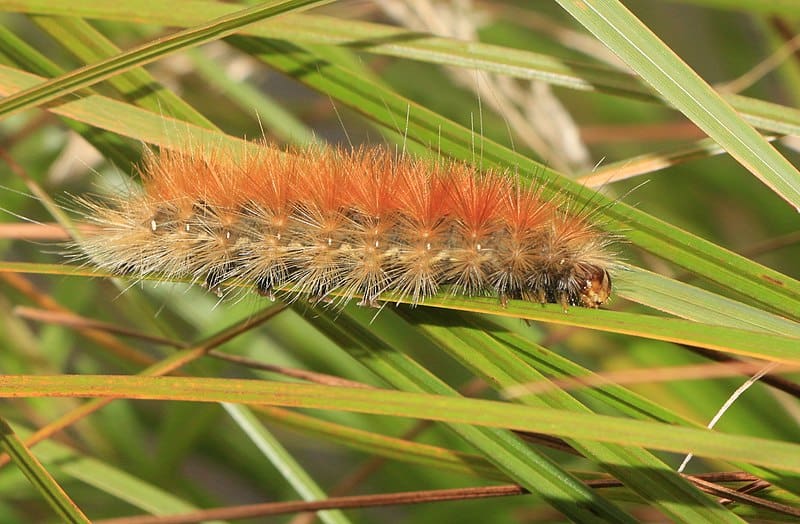
The Yellow Woolly Bear is the most commonly found yellow furry caterpillar in North America.
Unlike its name, the color of its long thin spiky hairs ranges from whitish yellow to orange to reddish brown – the most striking specimens are black and yellow with long pencil hair.
Yellow-Spotted Tussock Moth Caterpillar
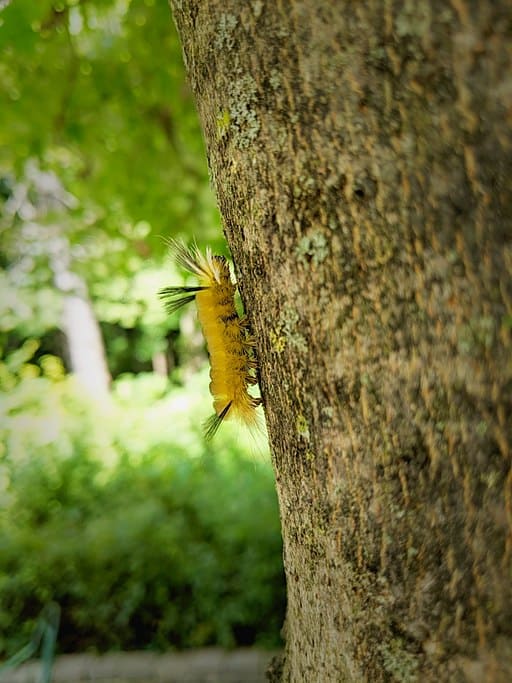
Yellow-spotted Tussock Moth Caterpillars are furry, bright yellow in color with black clumps of hair in each of its segments.
Sycamore Tussock Moth Caterpillar
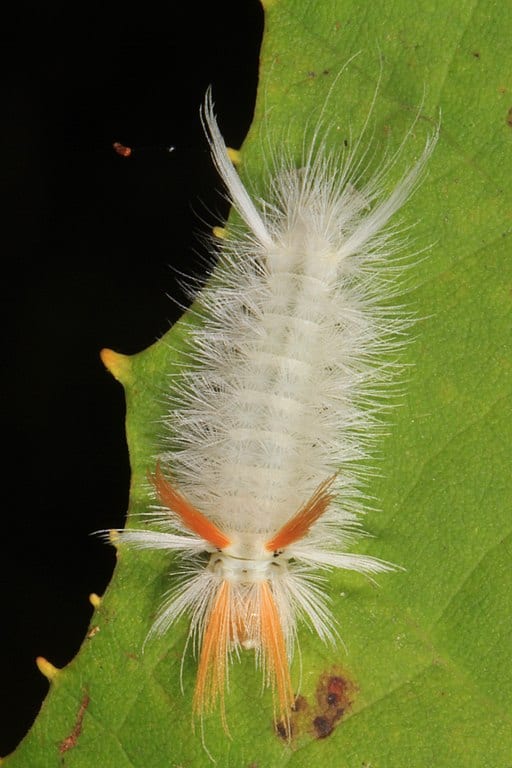
Sycamore Tussock Moth Caterpillars are covered with hair with yellow-orange heads. They exhibit two pairs of long, orange hair pencils and two pairs of white hair pencils in the front part of their bodies, and one pair of white-hair pencils towards the back.
American Dagger Moth Caterpillar
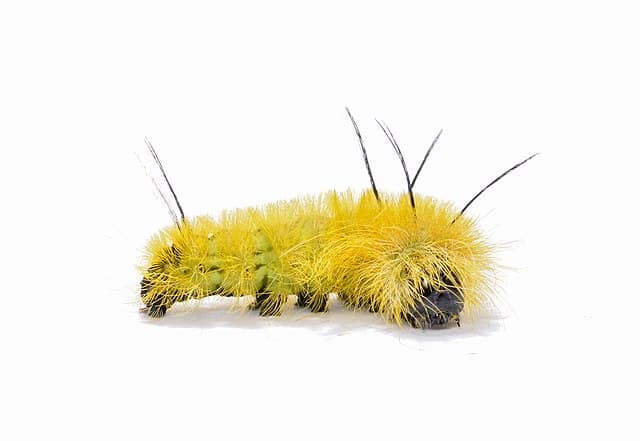
American Dagger Moth Caterpillars are bright yellow when young, turning to yellow and white when they mature. They have tufts of hair sticking out all over their body, with distinctive black tufts towards the ends.
Pale Tussock Caterpillar
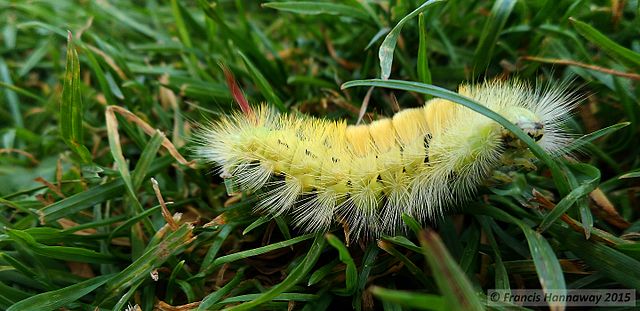
The Pale Tussock Caterpillars can be distinguished by their 4″ long tufts of yellow hair.
They have black bands separating their body segments and black and white hair towards the lower abdomen.
Giant Peacock Moth Caterpillar
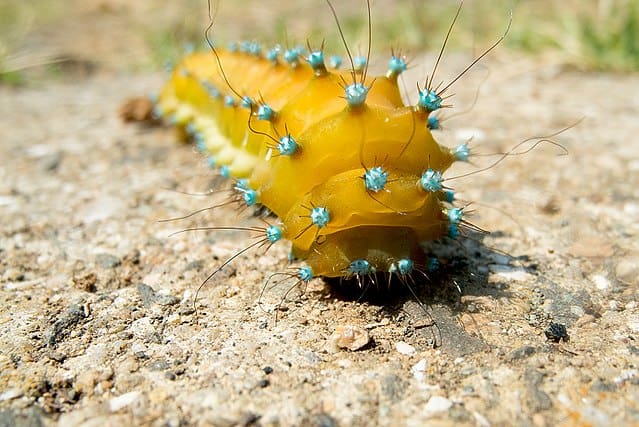
The Giant Peacock Moth Caterpillar is a huge insect that can reach 6-8″ in size. Dark early on, they mature to a golden-green color with darker orange brown bands in the middle of their segments, along with turquoise-blue tubercules and tiny irritating hairs.
Six-Spot Burnet Caterpillar
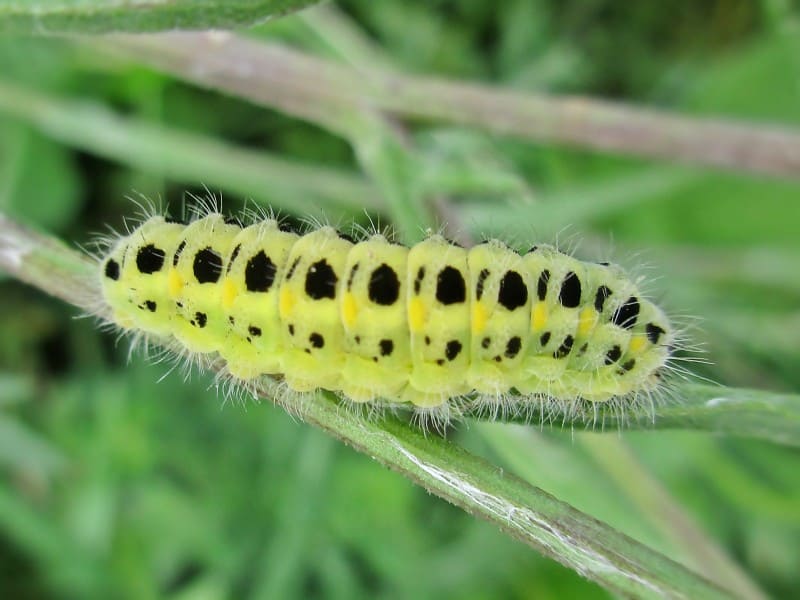
The Six-Spot Burnet caterpillar starts out greenish in color, but as it matures, the portly grub develops a bright yellow body with black spots and fine white fur. The coloration usually wards off predators, especially after it’s discovered that the grub produces lethal amounts of cyanide.
Tasar Silkworm Caterpillar
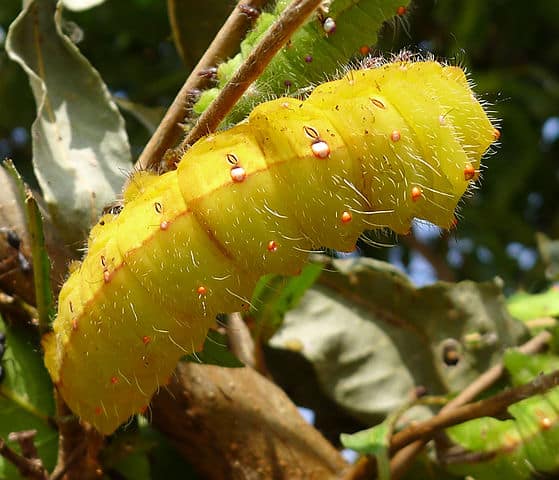
The Tasar Silkworm Caterpillar (also known as Tussar Silk Moth Caterpillar) goes through a pronounced yellow stage, during which it is plump with bright yellow coloration, fine white hairs on its body and white and red dots around its segments. They produce a high-quality desirable silk that is much sought after commercially.
Can Caterpillars Be Orange?
Orange is a natural color, which occurs due to pigmentation and is found on caterpillars. There are thousands of species, and among them there are a few that are completely orange. However, it’s often also the case that caterpillars with black, brown or gray bodies project as orange due to hairs or spines that flash prominently.
Are Orange Caterpillars Rare?
Orange caterpillars are quite common. The Sycamore Moth Caterpillar (Acronicta aceris) stands out in its habitat. The caterpillar of the colorful Cinnabar Moth (Tyria jacobaeae) is a contrast from the red and black moth itself.
The Garden Tiger Moth Caterpillar (Arctica caja) is a woolly bear variety. The Scarce Dagger Moth Caterpillar (Acronicta auricoma) is a pure black caterpillar that presents as orange due to its spiky orange-yellow setae.
The Oleander Caterpillar (Syntomeida epilais) is found on the bottom side of Oleander plants.
Where Can They Be Found?
Sycamore Moth Caterpillars are mainly found in Europe and the Middle East. Cinnabar Moth Caterpillars are native to Europe, as well as western and central Asia.
The Garden Tiger Moth Caterpillar is common in the US, Canada and Europe. The Scarce Dagger Moth Caterpillar is found in Central and Southern Europe, Asia Minor, the Middle East and Russia.
The Oleander Caterpillar was native to the Caribbean, but has spread to South and Central America, as well as the Southeastern US including Florida and Georgia.
Orange Caterpillar Examples & ID Guide
Orange is a natural pigmentation, so caterpillars of that color are easy to spot.
Sycamore Moth Caterpillar
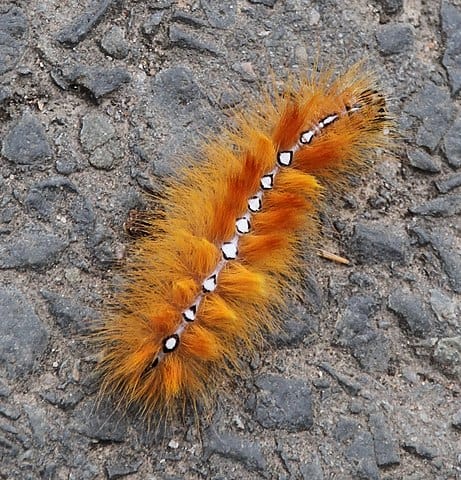
Sycamore Moth Caterpillars are hairy, with bright orange and yellow tufts standing out throughout its short body. They can also be recognized by the unique pattern that goes along the center of their back.
These caterpillars are quite small – They grow to be about 1.5 inches long, at most. They are often spotted in late summer wandering around.
Cinnabar Moth Caterpillars
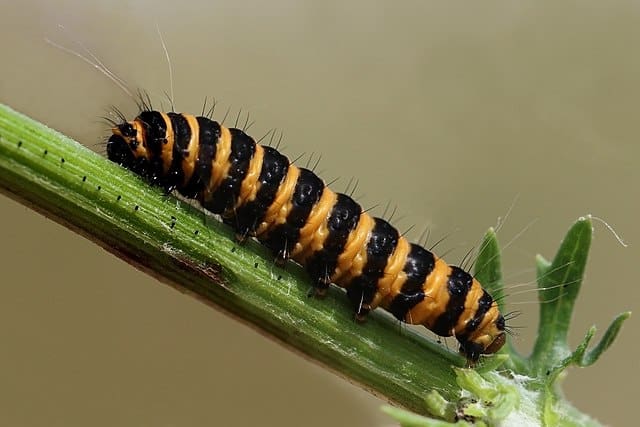
Cinnabar Moth Caterpillars grow distinctive as they become more mature, with bright orange bands on a jet-black background.
Garden Tiger Moth Caterpillar
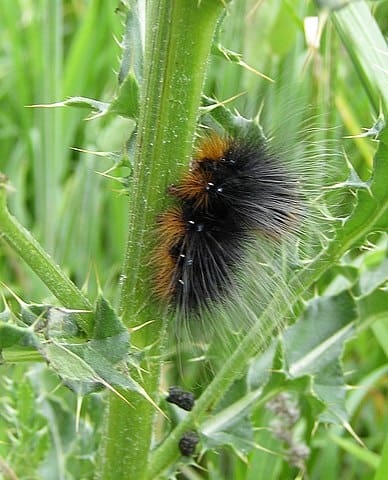
The Garden Tiger Moth Caterpillar has spiky black and gray hairs on top, with orange coloration over the sides and abdomen and on its head.
White tufts of hair line the fringes of the black parts.
Scarce Dagger Moth Caterpillar
The Scarce Dagger Moth Caterpillar has a pure black body, but its predominant appearance could be orange due to large tufts of orange and yellow spines throughout its body – it looks like a moth to predators.
The Oleander Caterpillar
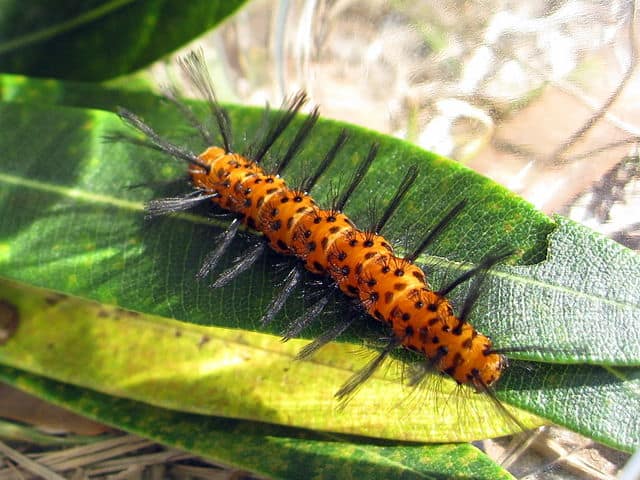
The Oleander Caterpillar is bright orange with black spots, thus easy to spot. However, you’ll have to look closely, since these caterpillars range in length from 3 to 40 mm).
Can Caterpillars Be Black?

Black pigmentation in caterpillars create black patches or bands on other backgrounds, zebra colors or predominantly black backgrounds with other, iridescent colors such as orange and red.
Are Black Caterpillars Rare?
Black caterpillars are common. Many beautiful moths and butterflies have black caterpillars.
Examples include the Monarch Butterfly Caterpillar (Danaus plexippus), also called the Milkweed, Common Tiger or Wanderer which is distinct in coloration but very different from the well-known Orange and Black Butterflies.
The pure black spiky Giant Leopard Moth Caterpillar (Hypercompe scribonia). One of the most unusual and striking black caterpillars in the Peacock Caterpillar (Aglais io). The Pipevine Swallowtail Caterpillar (Battus philenor) is distinctive for a number of reasons.
Where Can They Be Found?
Black caterpillars are abundant the world over, except in Antarctica, though certain rare species (like the ones mentioned above) have limited habitats.
The Monarch Butterfly Caterpillar is an iconic presence in North America. The Giant Leopard Moth Caterpillar is distributed through North and Central America, from Ontario down to Mexico and through Panama.
The Peacock Caterpillar is found in Europe and temperate parts of Asia, ranging as far East as Japan. The Pipevine Swallowtail Caterpillar is mainly found in Florida, Texas and California.
Black Caterpillar Examples & ID Guide
Black caterpillars are easy to spot, though greyish or brownish black colors may fade into the background depending on their habitat.
Monarch Butterfly Caterpillar
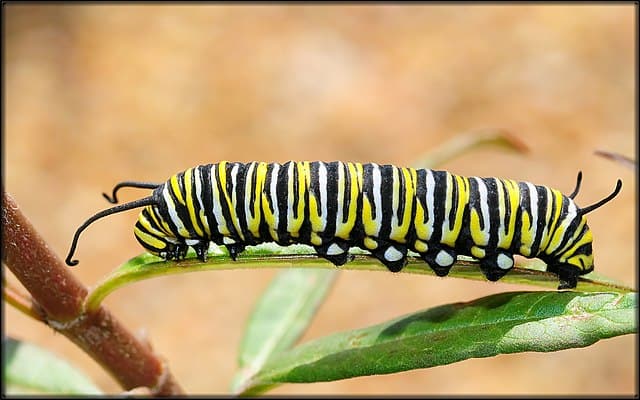
The Monarch Butterfly Caterpillar is greenish when young, but develops distinctive black, yellow and white alternating bands as it grows older.
Interestingly, the shades depend on the habitat. The caterpillars found in sunny areas are whiter, while those in colder climates are darker. If such caterpillars develop a mustier or hazier dark color, it’s usually the sign of a bacterial infection.
Giant Leopard Moth Caterpillar
The Giant Leopard Moth Caterpillar looks soft and fluffy but has sharp spines. Due to red bands between its segments, the insect looks black and red when crawling on your garden plants.
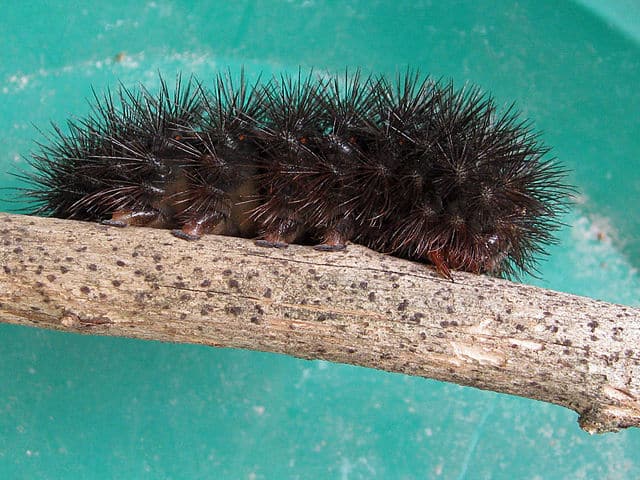
Peacock Caterpillar
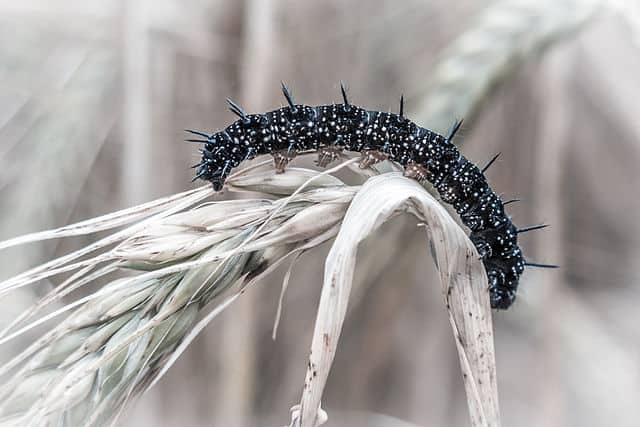
The Peacock Caterpillar has a rounded black head and multiple jet-black segments, which look striking due to the large number of spikes (which look threatening but are not really so) and tiny white dots on its body.
Pipevine Swallowtail Caterpillar
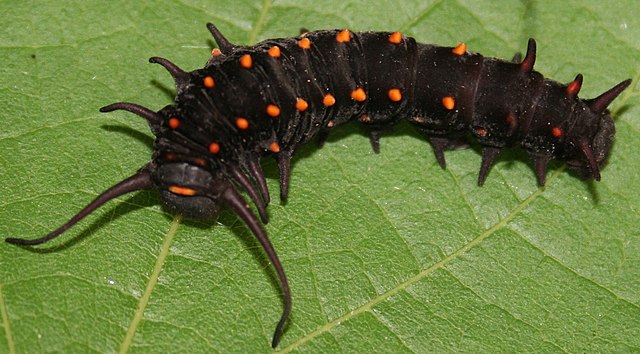
The Pipevine Swallowtail Caterpillar has a distinctive smooth jet-black body with bright red or orange spines throughout, including long ones on the sides of its head.
Can Caterpillars Be Brown?
Brown pigmentation is very common in caterpillars.
Are Brown Caterpillars Rare?
Brown caterpillars are common. The caterpillars of the Menelaus Blue Morpho (Morpho Menelaus) butterfly is reddish brown in color. Puss Moth Caterpillars (Megalopyge opercularis) have extremely venomous spines that can cause painful reactions to humans.
The Elephant Hawk Moth or Large Elephant Hawk Moth (Deilepila elpenor) Lackey Moth (Malacosoma Neustria) caterpillars are brightly colored.
The Tersa Sphinx Caterpillar (Xylophanes tersa) is a light to dark brown caterpillar that looks nearly black at times. The Black Cutworm Caterpillar (Agrotis ipsilon) is sometimes mistaken as a worm but is a true caterpillar.
Where Can They Be Found?
Brown caterpillars can be found in every continent except Antarctica. Menelaus Blue Morpho caterpillars can be mostly found in South American rainforests.
Puff Moth Caterpillars are found in Eastern and South-eastern US, Mexico and Central America. Elephant Hawk Moth Caterpillars are common in Central and Northern Europe and range east to China.
Lackey Moth Caterpillars are widely distributed across Europe, Asia and North Africa. Tersa Sphinx Caterpillars are common in the south of the US (including Texas and Arizona), as well as in South and Central America.
The Black Cutworm Caterpillar is found all over North America, as well as Central and South America, Australia, New Zealand, the Pacific Rim Countries, Europe, Asia and North Africa.
Brown Caterpillar Examples & ID Guide
Brown caterpillars may be difficult to spot, since their color provides handy camouflage.
Menelaus Blue Morpho Caterpillar
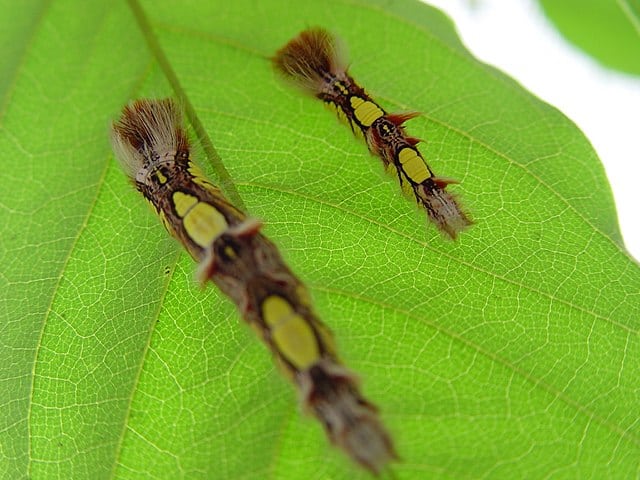
The Menelaus Blue Morpho caterpillar is reddish brown in color with green spots and stays well camouflaged within the rainforest habitat.
Puss Moth Caterpillar
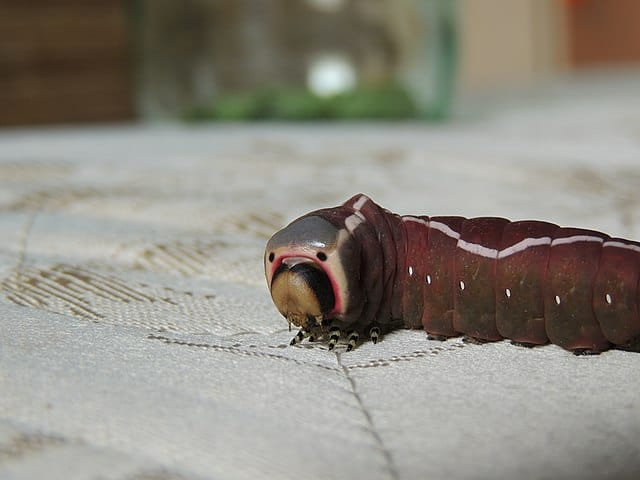
Puss Moth Caterpillars have a brownish-gray coat with a bright orange streak, their fur is clumped up giving the larva a puffed-up look. Their fur contains venomous spines.
Elephant Hawk Moth Caterpillar
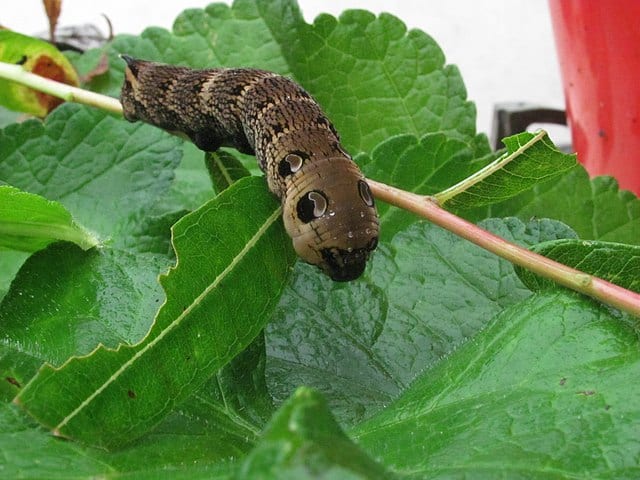
Elephant Hawk Moth Caterpillars are a uniform grayish brown, with black dots across the length of their bodies.
They possess a backward curving “horn” on their final segment.
Lackey Moth Caterpillar
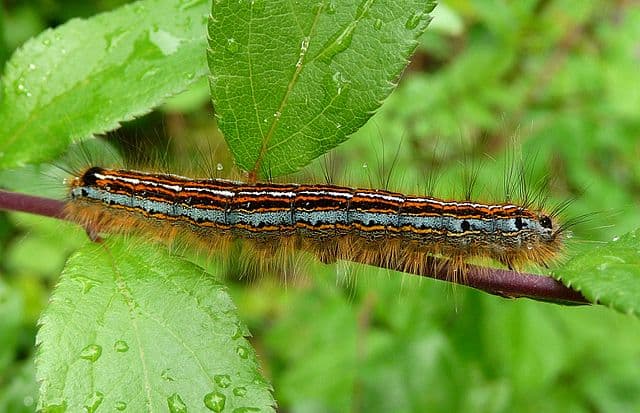
Lackey Moth caterpillars are brown, with bright blue, orange and white stripes, they form silken tents to regulate their temperatures.
Tersa Sphinx Caterpillar
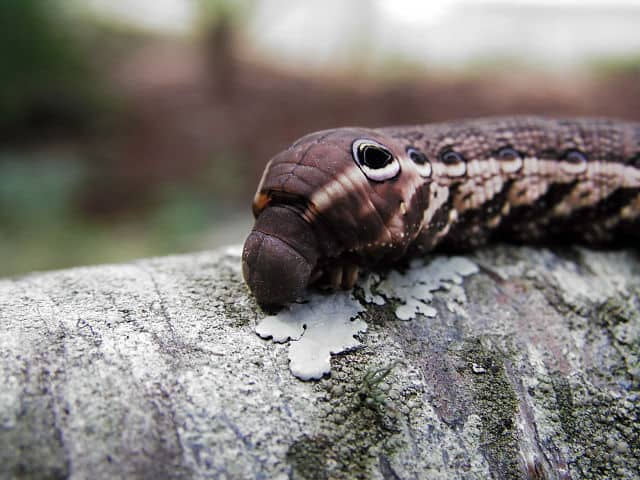
Tersa Sphinx Caterpillars range from light brown at certain stages to very dark brown-black shades. They are distinctive due to contrasting eye markings along their back that give the impression of being watched, as well as a horn at one end.
Black Cutworm Caterpillar
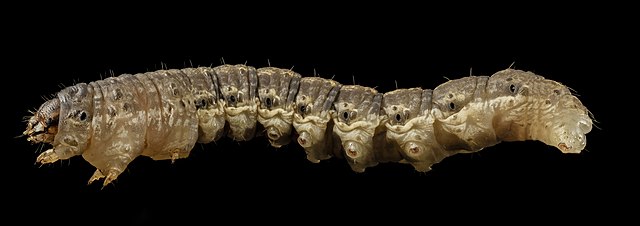
The Black Cutworm Caterpillar is a fat long dark brown-gray caterpillar which has no spikes, hairs or spines on its shiny dark body. It is not black per se, nor is it a work as it’s sometimes mistaken to be.
Can Caterpillars Be Blue?
Caterpillars are rarely a uniform blue in color, nor do they maintain a bluish sheen throughout their lives. Bluish green coloration, however, is not uncommon.
Are Blue Caterpillars Rare?
Blue is one of the colors that help caterpillars camouflage themselves, so it’s common. However, caterpillars that are completely blue are quite rare.
The Cecropia Caterpillar (Hyalophora cecropia) is one of the more unique looking grubs that start out yellowish-green, then turn bluish-green in later stages.
The Hickory Horned Devil Moth Caterpillar (Citheronia regalis) is also extremely distinctive, in a scary way. The Rough Prominent Caterpillar, also known as the White-Dotted Prominent or the Tawny Prominent (Nadata gibbosa) is another blue-green species.
The Eastern Tent Caterpillar (Malacosoma americanum) is a common sight during Springtime in North America. Another tent caterpillar, the Forest Tent Caterpillar Moth (Malacosoma americanum) is one of the cutest looking caterpillars you will see. The Plain Looper (Archaea argilla) Caterpillar is a common species in Australia.
Where Can They Be Found?
Cecropia Caterpillars can be found in North America. Hickory Horned Devil Caterpillars are common in the US, especially New England and the Deep South. White-dotted Prominents are common across North America, where they live in deciduous forests at high elevations.
Eastern Tent Caterpillars are considered to be a pest native to North America. The Forest Tent Caterpillar moth is found all over North America. The Plain Looper is found over much of Australia, particularly Queensland, New South Wales, Western Australia and the Northern Territories.
Blue Caterpillar Examples & ID Guide
Blue caterpillars are usually easy to identify.
Cecropia Caterpillar
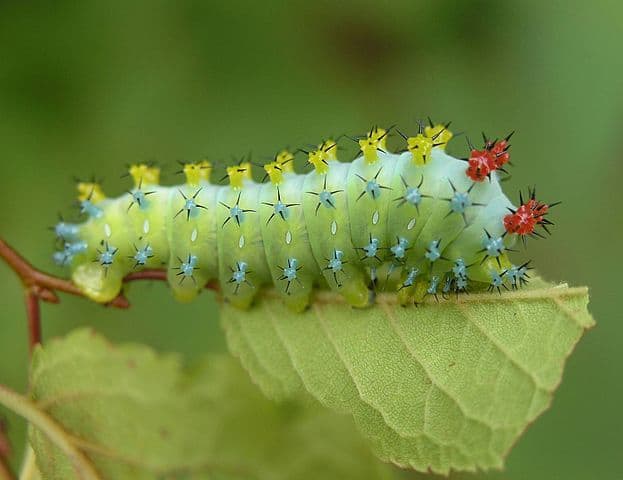
The Cecropia Caterpillar has a body divided into large ridge-like segments, but its most distinctive features are blue, yellow and orange tubercules with black hair sprouting from them – these bizarre looking grubs turn into beautiful moths.
Hickory Horned Devil Moth Caterpillar
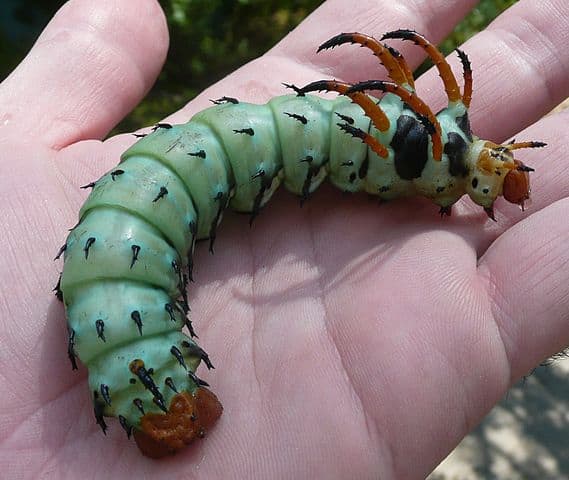
The huge 6″ long Hickory Horned Devil Moth Caterpillar is turquoise green in color with spiky red horns on one end of its body. Also, both ends of the caterpillar has red tips. Despite its menacing look, this caterpillar is harmless.
White-Dotted Prominent Caterpillar
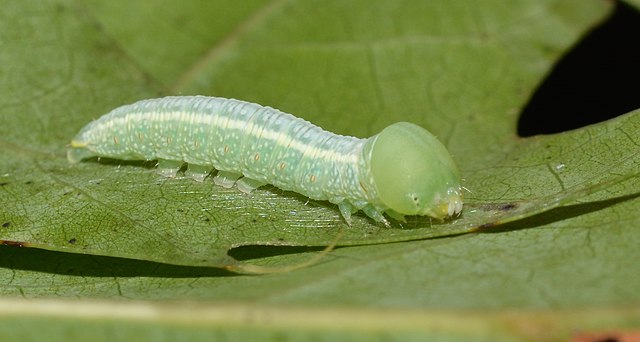
The White-dotted Prominent Caterpillar is blue-green when young, turning green close to pupation. The larva has a large head, yellow mandibles and a greenish yellow stripe down its body.
Eastern Tent Caterpillar
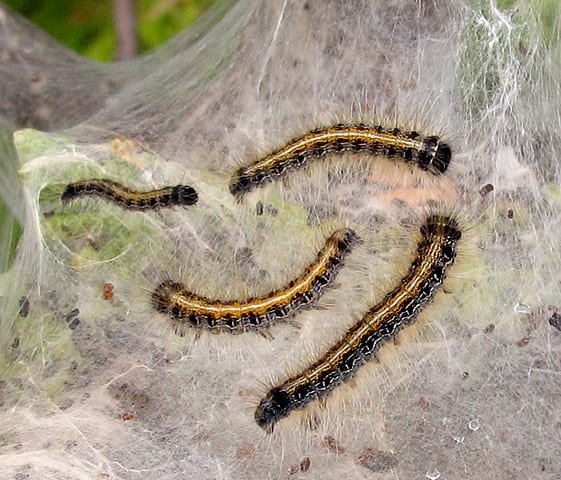
The Eastern Tent Caterpillar, which has a hairy body with areas of blue, white, black and orange stand out due to their habit of erecting tents from an early age.
The blue and white colors are structural, produced by sunlight reflecting off their cuticles.
Forest Tent Caterpillar
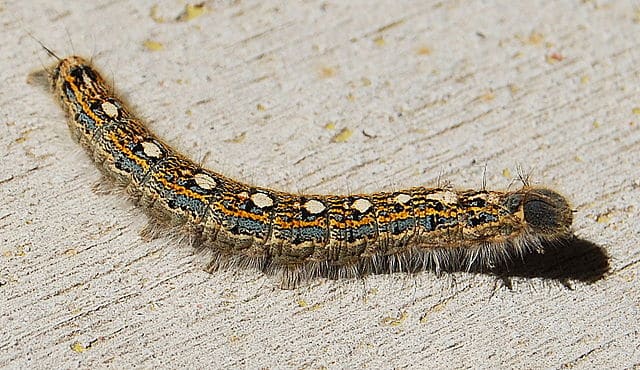
Forest Tent Caterpillars have a brownish underbelly, but their distinctive features are black and white penguin shapes woven into their blue backs, which are flanked with brown and black stripes.
Plain Looper
The Plain Looper is initially blue-gray with black spiracles, and a gray and white head. There are raised black and white markings on the second and last segments. Towards pupation, the caterpillars become reddish brown in color.
Can Caterpillars Be Red?
Red is an iridescent color that often exists with black or other bases in caterpillars.
Are Red Caterpillars Rare?
Red caterpillars are found all over the world. The Imperial Moth Caterpillar (Eacles imperialis) goes through multiple phases but ends up as a dark burgundy color in its fully grown (fifth instar) stage. The Saddleback Caterpillar (Acharia stimulea) is a distinctively patterned caterpillar found in North America.
The Shag-Carpet Caterpillar (Prothysana felderi) is named for its resemblance to a shag carpet. The caterpillar of the White Morpho Butterfly (Morpho Polyphemus) is another bright red presence, in contrast with the rather plain looking butterfly that emerges finally.
Where Can They Be Found?
Red caterpillars can be found all over the world, except Antarctica. The Imperial Moth Caterpillar is an extremely common species in the eastern part of the US.
The Saddleback Caterpillar is found over the eastern parts of North America, including south of the Yucatan Peninsula in Mexico. The Shag-Carpet Caterpillar is found in rainforests and cloudforests from Canada to Bolivia and Brazil.
The White Morpho Caterpillar is found all over Mexico and Central America up to Costa Rica.
Green Caterpillar Examples & ID Guide
Most species of red caterpillars are easy to spot due to their striking color.
Imperial Moth Caterpillar
The Imperial Moth Caterpillar in its most mature phase is bright burgundy colored, with burnt orange patches dorsally around the spiracles – the base of each spiracle may be white with black rings.
Saddleback Caterpillar
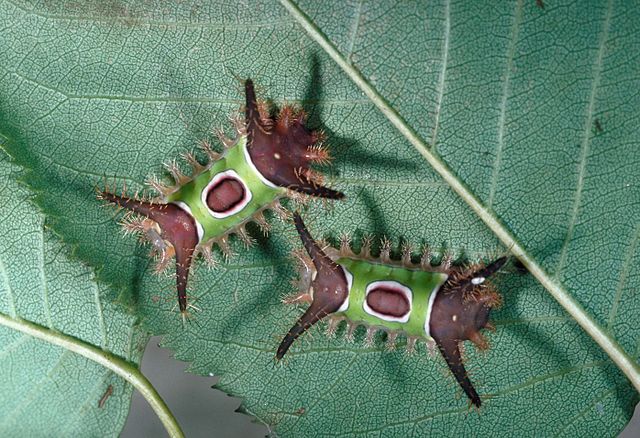
The Saddleback Caterpillar has a brownish-red color with a bright, lime-green saddle that has white-ringed brown dot in the middle of the back.
Shag-Carpet Caterpillar
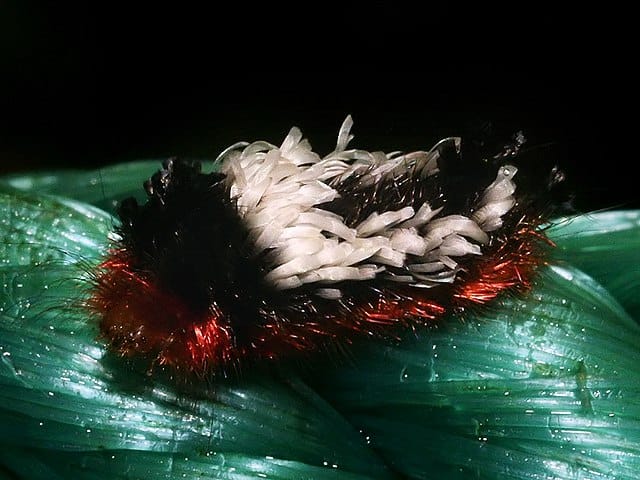
The Shag-Carpet Caterpillar is decidedly shaggy, with a central patch of grayish-black and white hair, surrounded by large, bright red patches towards the head, toes and sides.
White Morpho Caterpillar
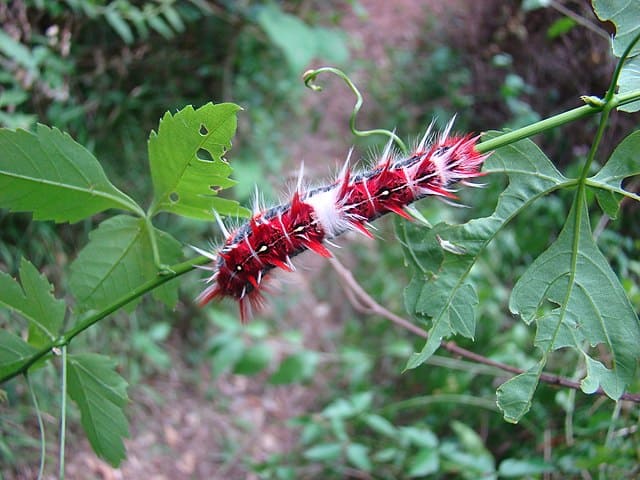
It often stands out in flaming red contrast to its surroundings. The White Morpho Caterpillar has a brushy body with fine sets of reddish hair-like growth at the two ends and in the middle of the body, alternating with yellow coloration.
Can Caterpillars Be Gray?
There are many species of gray, white or zebra colored caterpillars. Oftentimes, gray is combined with some other bright, iridescent color.
Are Grey Caterpillars Rare?
Gray caterpillars abound all around the world. A spectacular example of iridescence among a dull gray color is found in the Gypsy Moth Caterpillar (Lymantria dispar), also called the Asian Gypsy Moth or the European Gypsy Moth in those habitats.
The Vapourer Moth Caterpillar, also called the Rusty Tussock Moth Caterpillar (Orgyia antiqua), shows similar iridescence. The domesticated Silk Moth Worm (Bombyx mori) is an example of a commonly found gray (or grayish-blue) moth that does not show much iridescence.
The Walnut Caterpillar (Datana integerrima) actually tends towards black but appears gray overall as described below. The Mourning Cloak Caterpillar (Nympholis antiopa), is also known as the Spiny Elm Caterpillar due to its love for elm leaves.
Where Can They Be Found?
Gray caterpillars can be found on every continent except Antarctica. The Gypsy Moth Caterpillar is common all over the US, as well as Europe, Asia and North Africa.
The Rusty Tussock Moth Caterpillar is native to Europe but has now spread across the Northern Hemisphere including the UK, parts of North America and Asia. The Bombyx mori caterpillars are now common all over the world, having been domesticated for silk production thousands of years ago in China and Japan.
The Walnut Caterpillar is common to the eastern US and parts of Canada. The Mourning Cloak Caterpillar is common in the UK, Eurasia and North America.
Gray Caterpillar Examples & ID Guide
Gray caterpillars are often hard to spot due to their dirty white sheen, except when they are speckled with color. The Gypsy Moth Caterpillar is a prime example.
Gypsy Moth Caterpillar
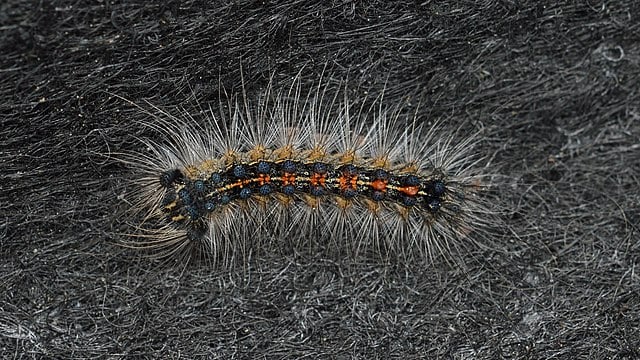
A furry gray body with setae is interspersed with ruby red and topaz blue dots that have earned it a place among one of the most alien looking species in the world.
Rusty Tussock Moth Caterpillar
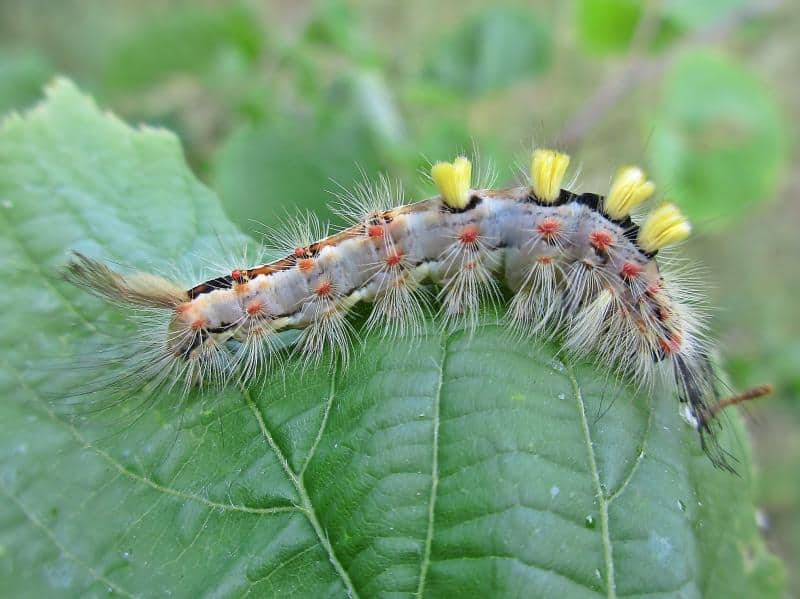
The Rusty Tussock Moth Caterpillar is a hairy species with spectacular humps, horns and a tail, with splashes of red and yellow on a dark gray body.
Silk Worm
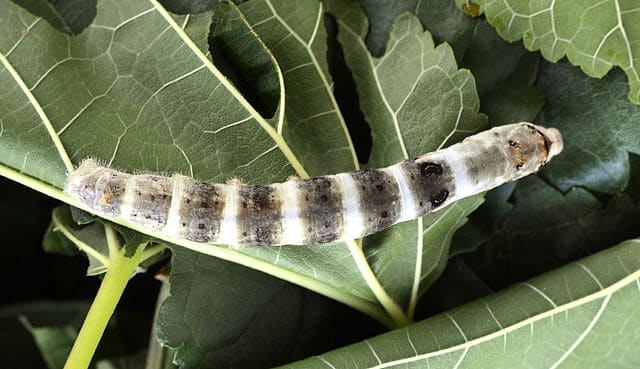
The domesticated Silk Worm is a prodigious producer of silk, much more so than its wild cousins. They have a grayish-blue body with black spots in each segment and are known for their fondness for mulberry leaves.
Walnut Caterpillar
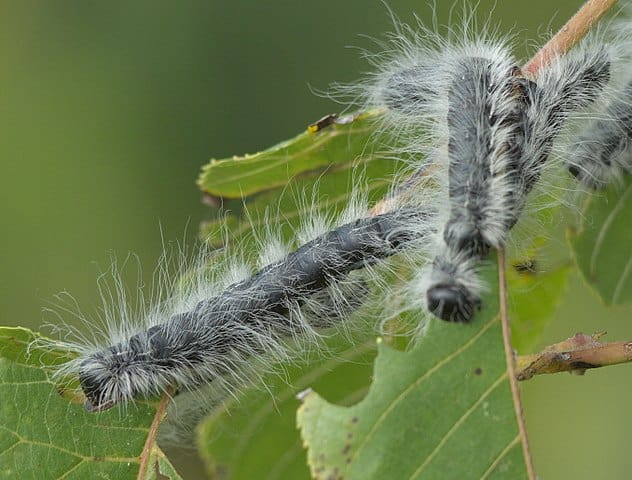
The Walnut Caterpillar is a black insect covered in thick grey-white hairs that make them appear dark gray.
Mourning Cloak Caterpillar
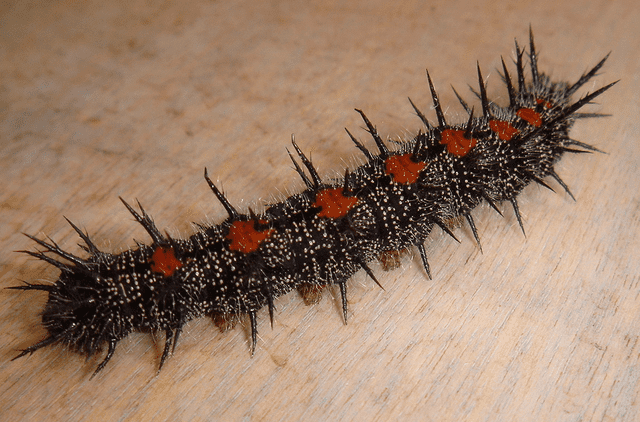
The Mourning Cloak Caterpillar is distinctive due to its gray-black body with tiny white speckles, reddish orange markings on each segment, and prominent spines sticking out in each direction.
Can Caterpillars Be Purple?
Purple caterpillars are not very common. Blue or purple iridescence does occur from time to time.
Are Purple Caterpillars Rare?
Purple caterpillars are not exactly rare. However, you do not always find a consistently purple color, it’s more common to find various shades of blue, black and purple co-mingled on a caterpillar’s body.
The White-blotched Heterocampa (Heterocampa umbrata) is a purple caterpillar species. Another species belonging to the genus Catocala has been spotted in the US.
Where Can They Be Found?
The White-blotched Heterocampa is common over the eastern US. The Grey caterpillars with Purple Undersides have been spotted all over the eastern US, from Massachusetts down to Texas.
Purple Caterpillar Examples & ID Guide
White-Blotched Heterocampa
The White-blotched Heterocampa can be distinguished by its bright and unusual colors. They change colors as they develop, but one of their brightest phases is pink and fuchsia as they feed on the leaves of oak trees.
Catocala caterpillars
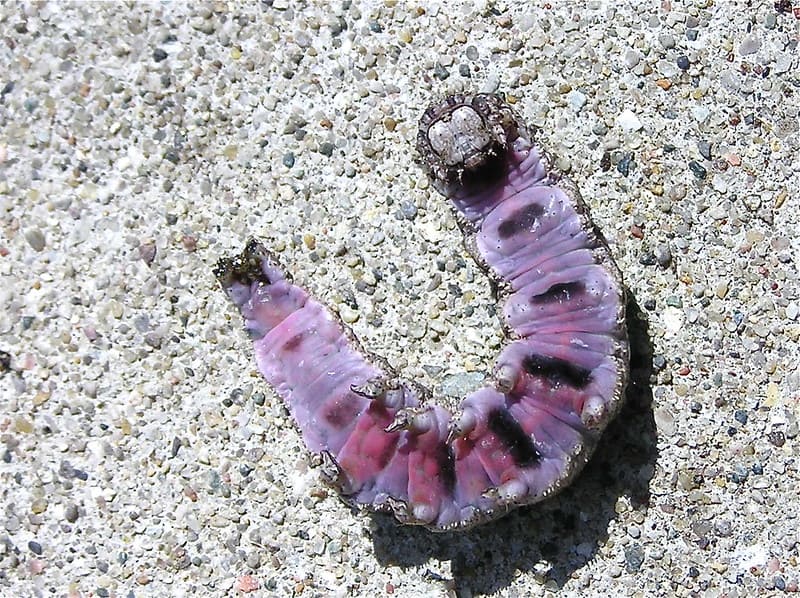
The Catocala caterpillars have a gay body withbright purple and pink undersides.
Can Caterpillars Be Pink?
Pink is not a color that exists in nature, it is not a wavelength or particle, and does not appear in the visible spectrum. Oftentimes, our brain perceives something to be pink, without the color actually being present. Some caterpillars do appear pink, but more often than not, they are a shade of red, brown or something in between.
Are Pink Caterpillars Rare?
Caterpillars that appear pink are rare in nature. Oftentimes, they are closer to purple or red. The Palm Budworm (Litoprosopus Coachella) is distinctly pink. There is also the White-blotched Heterocampa, mentioned in the previous section, which could be distinctively fuchsia colored.
Where Can They Be Found?
The Palm Budworm is common in Arizona, California and southern Nevada in the US. They feed on the flowers of palm trees. The White-blotched Heterocampa is common to eastern parts of the US.
Pink Caterpillar Examples & ID Guide
Palm Budworm
The Palm Budworm is easy to spot, with a smooth pink body and brown head.
The White-blotched Heterocampa
The White-blotched Heterocampa can be distinguished by its bright and unusual colors. They change colors as they develop, but one of their brightest phases is pink and fuchsia as they feed on the leaves of oak trees.
In Conclusion …
Caterpillars are everywhere. It’s often amazing to note the variations of color between the various phases of a caterpillar’s growth, and then its change as a brightly colored caterpillar changes into a gray, black or white butterfly or moth – or vice versa.
Despite some bright colors and spines, most caterpillars are not poisonous. But they do have a reputation for destroying plants and crops. If you think about it, though, that is only natural.
Caterpillars are voracious eaters, born to eat as much as possible so they can proceed to the next phase of evolution.
To learn more about caterpillars & their adult forms, check out these articles:
Can I Keep Butterflies As Pets? – Yes, here’s how
10 Peculiar Facts About Butterflies
The Color of Butterflies – Explained
Recent Posts
Tiny Black Bugs in Bathroom NO WINGS: What They Are and What to Do!
Finding tiny black bugs in your bathroom can be uncomfortable, to say the least. Especially if they are persistent, or they appear in very large numbers, which they often like to do. When it...
Tiny Black Bugs in Plant Soil - What Are They & What To Do About It
A short horror story: You get a new houseplant. You do your best to take care of it. You’ve ensured that it has the right soil, the right amount of sun, it gets enough water. And then one day, you...

